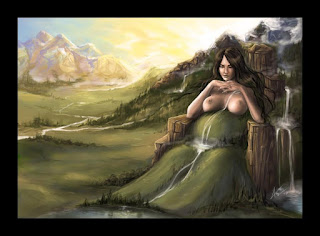Happy Earth Day
Mother Nature (sometimes known as Mother Earth or the
Earth-Mother) is a common personification of nature that focuses on the
life-giving and nurturing aspects of nature by embodying it, in the form of the
mother.
Ki is an earth goddess in Sumerian mythology
Ninhursag was a mother goddess of the mountains, and one of the seven great deities of Sumer. She is principally a fertility goddess. Temple hymn sources identify her as the 'true and great lady of heaven' (possibly in relation to her standing on the mountain) and kings of Sumer were 'nourished by Ninhursag's milk'.
Gaia "the
Deep-Breasted One” is the ancient Greek Goddess of the earth; some said she was
born directly from Khaos with Eros (Love) and Nyx (Night). She is credited with
creating the universe, and is known as the mother of many including: Ouranos,
the starry sky; Pontos, the sea; the mountains; the twelve Titans and
Titanesses; the three Cyclopes, who had but one eye each; the three
Hekatonkheires, hundred-handed monsters; the Erinyes, or Furies; the Melic
nymphs; the monsters Typhon, Ladon and Echidna; the sea-monster Charybdis; and
the serpent-king Erechtheus, whose temple is the Erechtheus on the Acropolis.
Gaea is considered the mother of all, who nourishes and cares for her children,
and brings rich blessings.
Rhea was known as
an Earth Goddess and worshipped with orgiastic rites in Asia Minor & Crete.
Her name means “flow,” apparently in reference to female menstruation, and
“ease,” perhaps in reference to easy childbirth. Following the rise of her son
Zeus to status as king of the gods, she disputed her portion of the world and
ended up retreating to the mountains where she surrounded herself with wild
creatures. She is usually associated with lions or with a chariot pulled by
lions.
Demeter was the
goddess of the earth, and more especially of the earth as producing fruit, and
consequently of agriculture. That's the reason ancient poets called human food
or bread "the gift of Demeter". The beloved goddess of the harvest
also brought to humans the cultivation of grain (wheat and barley) and to
instruct mankind how to sow it.
Jord is Nordic version of Gaia. Jord or Jörð is the
goddess of Midgard (the Earth in the vision of the Nordic). Some legends say
that she is sister of the sea god, Njord, although others affirm that she is
lover of Njord. It is the goddess who allows and causes all things to grow on
the earth, from trees to flowers. Jord is a Jotun, although it is also
treated as an Æsir, which shows how, unlike what is commonly thought; the
Jotuns are not necessarily creatures. Jord is also mother of the thunder god
Thor also mother of Meili, being Odin the father. Unlike the other Æsir, she
does not remain in Asgard, but in Midgard to take care of the land.
Tlazolteotl is
the Aztec and Toltec Earth Mother Goddess of guilty pleasures, who both
inspires and forgives carnal acts. She is a love and earth Goddess Who is said
to remove sins from her worshippers by absorbing them into her. The punishment
for adultery under harsh Aztec law was death; but if the offender confessed to
Tlazolteotl he or she was absolved and the law would not touch them. However, a
person was only allowed one confession per lifetime, so people would leave it
as long as they could!
Pachamama is a goddess
revered by the indigenous people of the Andes. She is also known as the
earth/time mother. In Inca mythology Mama Pacha or Pachamama is a fertility
goddess who presides over planting and harvesting. She causes earthquakes and
is typically in the form of a dragon. She is also an ever present and
independent deity who has her own self-sufficient and creative power to sustain
life on this earth. Pachamama is the wife of Pachacamac and her sons are Inti
the sun god, and Killa, the moon goddess. In Quechua cosmology, these are the
four organizing principles of nature based on water, earth, sun, and moon.
Llamas as well as burned, elaborate miniature garments are sacrificed to her.
After the conquest by Spain, which forced conversion to Roman Catholicism, the
figure of the Virgin Mary became united with that of the Pachamama for many of
the indigenous people. In pre-Hispanic literature, Pachamama is seen as a cruel
goddess eager to collect her sacrifices. As Peru began to form into a nation,
however, Pachamama began to be–and to this day is–perceived as being benevolent
and giving. She is also seen as nature itself. Thus, problems arise when people
take too much from nature because they are taking too much from Pachamama.
It is interesting to note that while in most cultures the deity associated with the earth and it's bounty is a woman ("Mother Earth", Demeter of the Greeks, etc...), the Egyptians chose a male for this role.
Geb is the
Egyptian god of the earth. He is the son of Shu and Tefnut and the brother as
well as husband of Nut. Geb ruled as king of the gods after his father, Shu,
abdicated. He himself would eventually pass down the throne to his eldest son,
Osiris. After abdicating, Geb was made the judge of divine affairs and lord of
the earth. As the God of earth, the earth formed his body and was called the
"house of Geb," He was also often portrayed lying on his side on the
earth, and was sometimes even painted green, with plants springing from his
body. Earthquakes were believed to be the laughter of Geb. Therefore he is one of
the gods who watch the weighing of the heart of the deceased in the Judgement
Hall of Osiris. The righteous that were provided with the necessary words of
power were able to make their escape from the earth but the wicked were held
fast by Geb.








Comments
Post a Comment